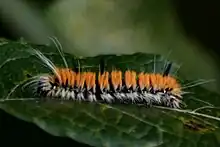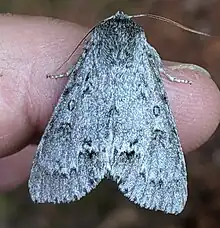Acronicta insita
Acronicta insita, the large gray dagger or fingered dagger, is a moth of the family Noctuidae. The species was first described by Augustus Radcliffe Grote in 1874.[2][3] It is found from Newfoundland west to the Pacific coast and Vancouver Island and Haida Gwaii, British Columbia, south to North Carolina and Colorado.
| Acronicta insita | |
|---|---|
 | |
| Acronicta insita, fingered dagger, Washington | |
| Scientific classification | |
| Domain: | Eukaryota |
| Kingdom: | Animalia |
| Phylum: | Arthropoda |
| Class: | Insecta |
| Order: | Lepidoptera |
| Superfamily: | Noctuoidea |
| Family: | Noctuidae |
| Genus: | Acronicta |
| Species: | A. insita |
| Binomial name | |
| Acronicta insita Grote, 1874 | |
| Synonyms[1] | |
|
Acronycta dactylina Grote, 1874 Acronycta denvera Smith, 1905 Acronycta hesperida Smith, 1897 | |

Acronicta hesperida and Acronicta dactylina were formerly considered to be separate species,[4] but are now considered a synonym.[5]
The wingspan is 45–55 mm. Adults are on wing from May to July in one generation depending on the location.
The larvae feed on alder, birch, poplar, hawthorn and willow.
They have fine hairs that are actually hollow, containing a toxin within. If direct contact is made through handling or even indirect contact through clothing, shaking a tree branch with a alder dagger caterpillar on it can result in exposure to these fine hairs. Mild to severe rashes may appear for up to a week and may spread easily to other areas of the body through clothing rubbing on exposed area or scratching. Some people react more seriously while others have no reaction at all. Applying strong adhesive tape to the area immediately after exposure may help to remove the fine hairs from your skin/clothes.
References
- "Acronicta insita". mothphotographersgroup.msstate.edu. North American Moth Photographers Group. Retrieved 30 September 2021.
- Savela, Markku, ed. (August 29, 2020). "Acronicta dactylina (Grote, 1874)". Lepidoptera and Some Other Life Forms. Retrieved October 19, 2020.
- Beccaloni, G.; Scoble, M.; Kitching, I.; Simonsen, T.; Robinson, G.; Pitkin, B.; Hine, A.; Lyal, C., eds. (2003). "Acronicta insita". The Global Lepidoptera Names Index. Natural History Museum. Retrieved October 19, 2020.
- Mayr, Ernst (June 1996). "What Is a Species, and What Is Not?". Philosophy of Science. 63 (2): 262–277. doi:10.1086/289912. JSTOR 188473. S2CID 85926575.
- "North American Moth Photographers Group, Acronicta insita". Retrieved 2021-09-30.
External links
- Anweiler, G. G. & Schmidt, B. C. (July 2002). "Species Details Acronicta dactylina". University of Alberta Museums. E.H. Strickland Entomological Museum. Retrieved November 10, 2020.
- McLeod, Robin (June 16, 2020). "Species Acronicta insita - Large Gray Dagger - Hodges#9202". BugGuide. Retrieved November 10, 2020.